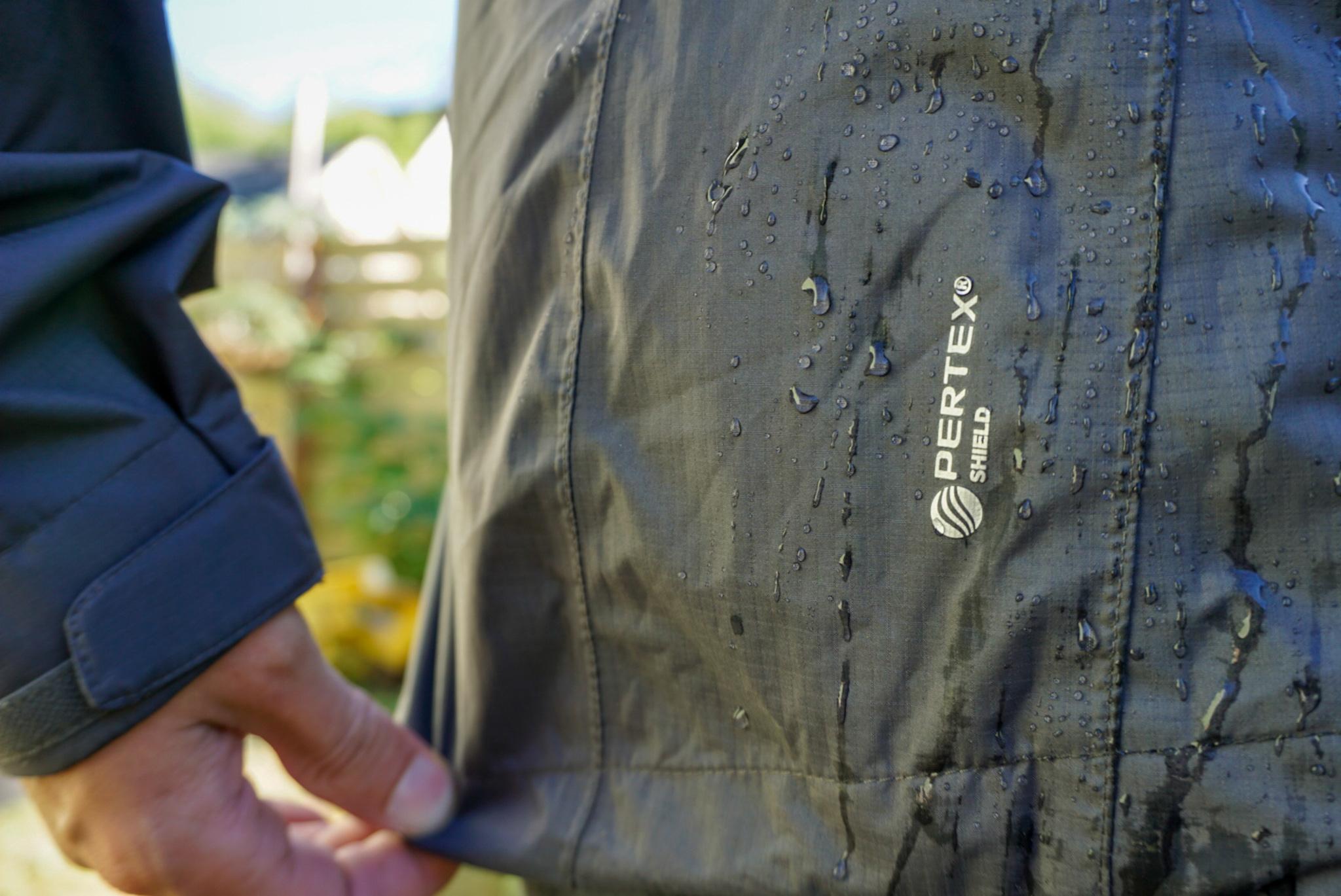We’ve all worn a trash bag in a pinch. And while almost anything is better than being soaking wet, nothing beats a purpose-built rain jacket with the right combination of features and price to meet your needs.
For more than five years now, we have shouldered close to 50 different rain jackets in just about every different name for rain — pulling together everything from the best rain jackets for bumping around town, to the best ultralight shells for long-distance thru-hiking, and even techy rainwear for the sport-specific demands of trail running, cycling, and climbing. Senior Editor Nick Belcaster leads our efforts, and never lets a good rain shower go to waste.
During testing, we aimed for the worst weather windows to challenge the waterproofing, livability, and rough-and-tumble durability of these jackets. We paid close attention to performance over entire seasons, and if the weather failed to materialize, we weren’t above busting out the garden hose. Every jacket was backpacked in, worn hard, and put away wet.
Scroll through to see all of our recommended buys or jump to the jacket you’re looking for. At the end of our list, be sure to check out our comprehensive rain jacket buyer’s guide, as well as our comparison chart. And if you still have rain jacket questions, take a look at our list of frequently asked questions.
Editor’s Note: We updated our rain jacket guide on November 2, 2023, to add additional information on rain jacket categories and waterproof membranes, and ensure that our selection is still current.
The Best Rain Jackets of 2024
- Best Overall Rain Jacket: Outdoor Research Foray Superstretch Jacket
- Best Budget Rain Jacket: REI Co-op XeroDry GTX
- Best Value Rain Jacket: Patagonia Torrentshell 3L Jacket
- Best Premium Rain Jacket: Arc’teryx Beta Jacket
- Best Ultralight Rain Jacket: Montbell Versalite Jacket
- Best Rain Jacket for Running: Janji Rainrunner Pack Jacket
- Best Breathability: The North Face Dryzzle FUTURELIGHT Jacket
Rain Jackets Comparison Chart
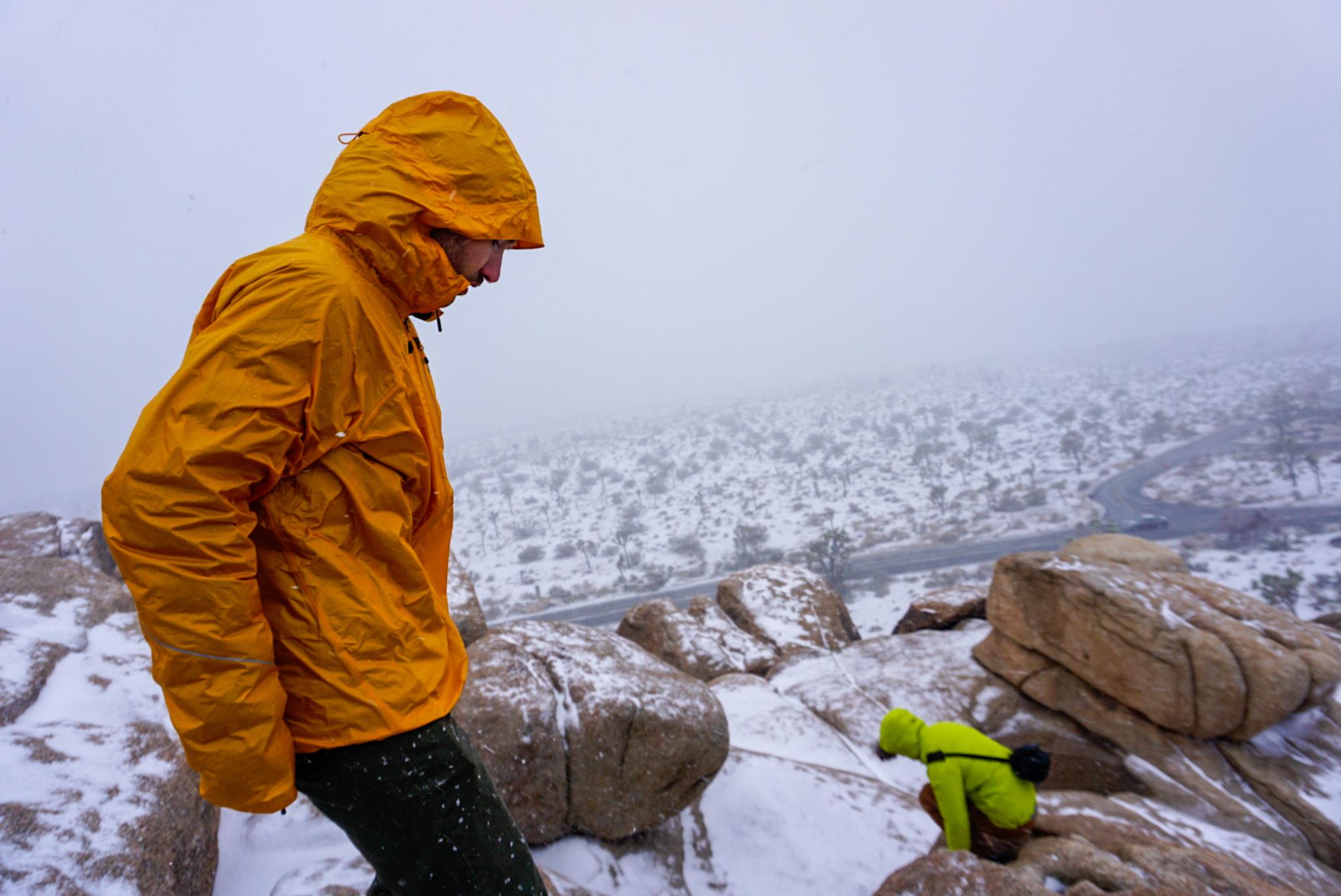
How We Tested Rain Jackets
Our team of testers has braved storms from the rain-drenched foothills of the Pacific Northwest to the mountains of Colorado for half a decade now to review and publish rain jacket guides for men and women. The GearJunkie crew isn’t afraid of a poor forecast, and our gathered rain jacket knowledge is pulled together here to guide your rain jacket choice. While we might be a bit wet behind the ears, it’s not for a lack of experience.
Senior Editor Nick Belcaster is no stranger to a little precip, and is the principal tester for this guide. Living and playing in the state of Washington requires either a lot of patience in waiting for the weather to change, or a lot of gumption to get outside anyways. Belcaster has also thru-hiked the Pacific Crest Trail, and has previously professionally equipped alpine climbers for whatever conditions they might encounter, including week-long deluges.
For this guide, we considered a broad range of uses for rain jackets, and included selections for both city and outdoor use. We consulted online resources, talked shop with brands, and then hit the field to pull our hoods up and let the skies open. From time spent on long trails to running laps on ice climbs, rain shells are often put to the test in a wild variety of conditions, and we aimed to review them in a broad spectrum of environments.
Our rain jacket testing occurs year-round, but mostly during the wettest months of the autumn in the Pacific Northwest. Belcaster, along with a crew of dedicated trail hounds, have been pulling on waterproofs and treading out into uncertain weather patterns for more than 5 years — collectively testing nearly 50 different rain jackets. Our testing aims to challenge these jackets, and looks at waterproofing over 24-hour periods, breathability during hill climbs, and durability against dense Cascadian bushwhacks.
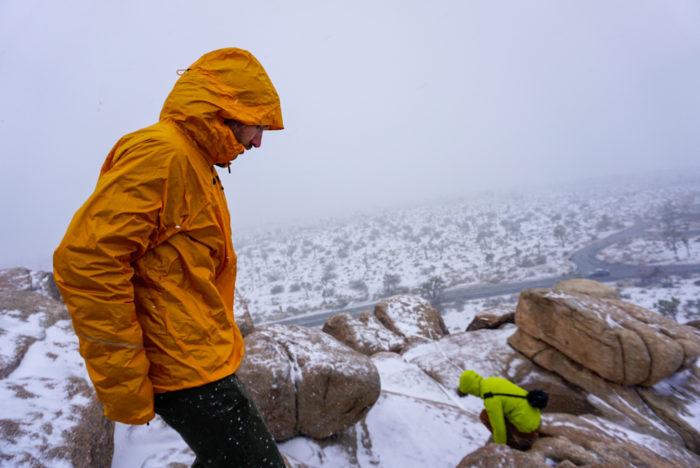
Buyer’s Guide: How to Choose a Rain Jacket
There are a lot of rain jackets on the market. And while having options is great, it can be overwhelming to choose. In this buyer’s guide, we’ll explain the most important factors to keep in mind when deciding on the best rain jacket for your needs.
Rain Jacket Categories
Everyday Use
It’s true; when it rains, it does always seem to pour, and if you live somewhere where it does so frequently, you’ll need a rain jacket that’s ready to take on day-after-day deluge and cover you on your commute or expedition to the mailbox.
A rain jacket meant for everyday use will prioritize ease of use over much else, which often means a casual cut meant to toss over anything you’re already wearing. Because of this, they may weigh a little more than their backpacking cousins, but make up for it in durability. Thicker denier face fabrics are often employed to up the wear factor, which also prolongs the time it takes the jacket to wet out.
Functional features such as Velcro wrist closures, hand warming pockets, and hoods with some adjustability are all standard, though you won’t often see more sport-specific features such as helmet-compatible hoods, or two-way front zippers. One of our favorite do-it-all jackets is the Patagonia Torrentshell 3L, a shell that doesn’t demand much for the protection and everyday use it provides, but we also lean on the REI Co-op XeroDry GTX, Rab Downpour Plus 2.0, and Mountain Hardwear Stretch Ozonic as everyday rain jackets.
Hiking and Backpacking
Rain jackets for hiking and backpacking take their jobs a bit more seriously, and need to contend with a rapidly filling backpack to ensure they make the cut. You’ll likely be hiking off into more remote locales for longer periods of time, and should look for a rain jacket with a waterproof membrane to match. Consider shells of 2.5- or 3-layer layups, which will stave off wetting out for longer, and often sport higher breathability numbers.
When hiking in a rain jacket, we like shells that combine mechanical and membrane breathability to continually move moisture out as we huff uphill. While their overall waterproofing numbers may be a bit lower, polyurethane membranes often move moisture at a better rate over their 2-2.5 layer GORE-TEX counterparts. Aim for a number north of 20,000 g/m² if you plan on hiking in your rain shell often. For day hikes, we often reach for the Outdoor Research Foray Superstretch, Patagonia Torrentshell 3L, and Outdoor Research Motive AscentShell.
Packability, too, is in high demand, and certainly so for backpacking rain jackets. Here you may encounter more ultralight rain jackets, which leverage high-performance membranes, light denier face fabrics, and minimal feature sets to disappear into your backpack. The Montbell Versalite always finds its way into our thru-hiking packs, with the Zpacks Vertice and Norrøna Falketind not far behind.
Performance
This is the realm of sport-specific rainwear, and where you’ll likely find jackets that are fine-tuned for heading further into terrain that’s whipped by rain on a constant basis. Rain jackets of this ilk are more similar in many aspects to hardshell jackets, which is rainwear with extra durability baked in for treading into mountainous terrain and activities.
You’ll pay for the performance, but the tradeoff comes in tougher shell materials, highly breathable waterproof membranes, and feature sets that make them more amenable to action while wearing, rather than hiding away inside. Hoods are often much more adjustable, with multiple corded zones to dial in your fit, and may also be oversized to fit over a climbing or ski helmet.
Exterior pockets typically are set higher on the torso, which allows access to them while wearing a backpack hip belt or climbing harness. The interior of these jackets, too, will have a bit more of a premium feel to them, with high-quality linings that are meant to protect the membranes for longer and promote water wicking.
The Arc’teryx Beta makes a strong case for its price tag here, and the 3-layer GORE-TEX it utilizes is top-of-the-line when it comes to rainwear, but don’t count out the North Face Dryzzle FUTURELIGHT or Patagonia Storm10, both jackets built with impressive tech.
Waterproofness
Given enough time and pressure, nothing is truly waterproof. Even the yellow rubber slickers that swaddle fisherfolk will eventually yield to enough H₂O, which means a little science is needed in order to understand relative water resistance in rain jackets.
Waterproofness is measured by the amount of water that can pile up on fabric before it leaks over a period of 24 hours. The minimum standard to call something waterproof is 1,000 mm, which should generally be capable of handling everyday front country use, like walking your dog around town in a light drizzle. But for outdoor adventures with severe weather, you’ll want to find a jacket with a waterproof rating between 5,000 mm and 30,000 mm.
Pressure can also lower the waterproofness of your rain jacket, and can be introduced from backpack straps or heavy snow. It is important to note that waterproofness and breathability are two metrics pulling in opposite directions of one another, and that superior water resistance will require some concessions in the breathability department.
- 5,000 mm: Where technical rain outerwear for outdoor adventures begins
- 5,000-10,000 mm: Waterproof under light rain or snow and no pressure
- 10,000-15,000 mm: Waterproof under many conditions, except under pressure
- 15,000-20,000 mm: Waterproof under heavy rain and snow
- >20,000 mm: Waterproof under heavy rain, snow, and pressure
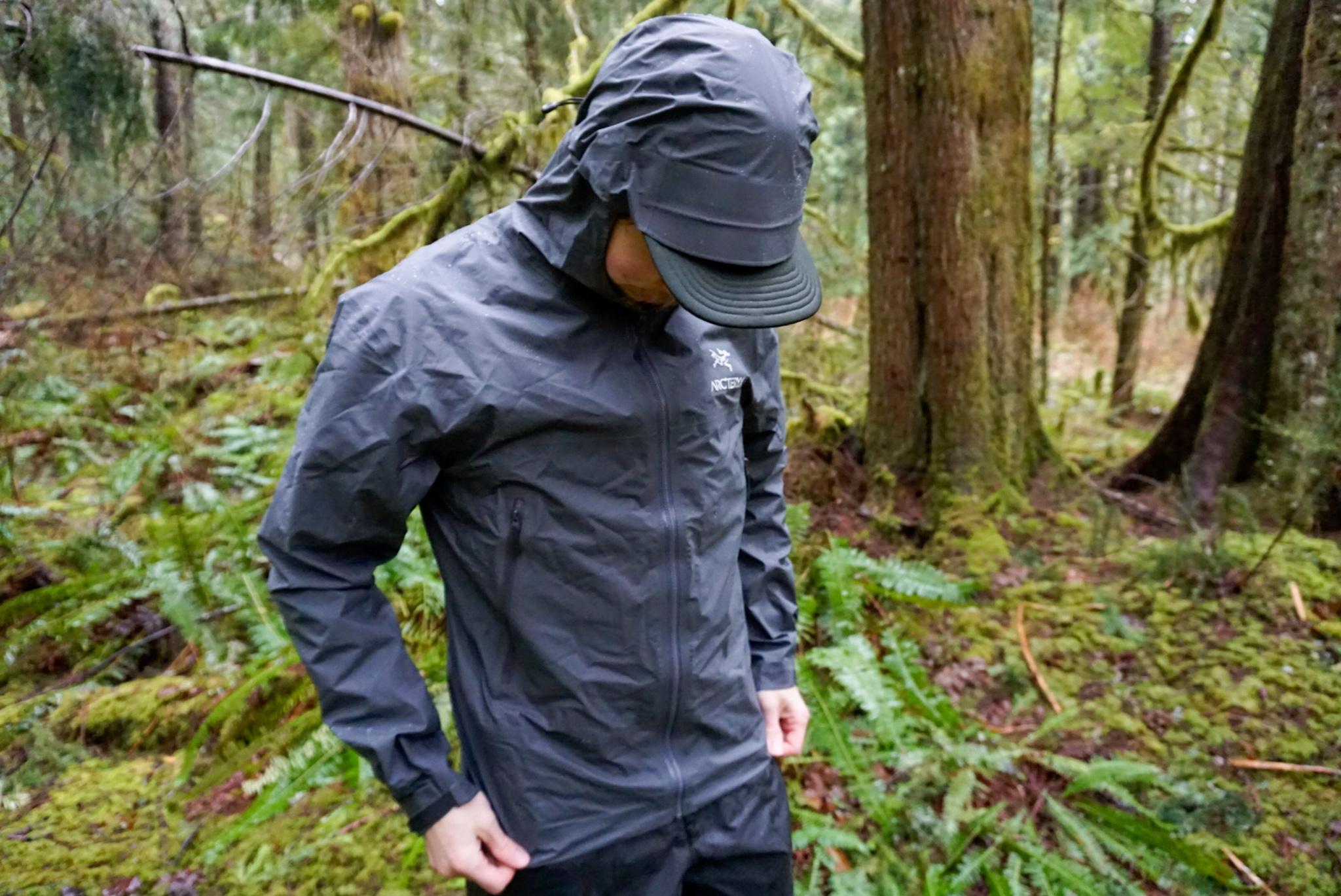
Breathability
As humans, we tend to perspire as we run, hike, or climb in our rain jackets, so having a shell that is breathable should be highly valued. Measured most often by the Moisture Vapor Transmission Rate (MVTR) test, higher values in g/m² denote a better ability to allow perspiration to pass out of a jacket.
Jackets intended for high-output activities will have a breathability rating of 20,000 g/m² or more, while lesser ratings between 10,000 and 15,000 will suffice for in-town use or when packability is the primary goal.
MVTR and RET Testing
The Moisture Vapor Transmission Rate, or MVTR, is the most commonly used test for measuring the breathability of waterproof membranes. This rate can be measured through a number of different tests, but the most common metric used is given in g/m²/24 hours. Higher values on the MVTR test give you a better idea of the jacket’s ability to pass moisture, but it isn’t the end-all say as other factors such as ambient humidity play a large role as well.
Budget-minded jackets like the Black Diamond StormLine Stretch sport an MVTR rating of 10,000 g/m², which isn’t quite at the standard of 20,000 g/m² rating we like to see in jackets meant to be used during high heart rate activities. At the other end of the spectrum, specialized shells like The North Face Dryzzle FUTURELIGHT boast impressive values of 75,000 g/m².
The RET, or Resistance to Evaporation rating has been gaining steam in recent years, with high-end GORE-TEX membranes being notable adopters. This rating uses a simulated perspiration test, and values here are the inverse of the MVTR, with lower values showing a higher ability for moisture transfer.
A jacket with a RET value of <6 will really pump out perspiration and is rated as extremely breathable on the RET scale. Fabrics with a RET score of between 6 and 12, like the Norrøna Falketind Paclite Rain Jacket, land in the highly breathable camp, and ratings of >12 are only moderately breathable.
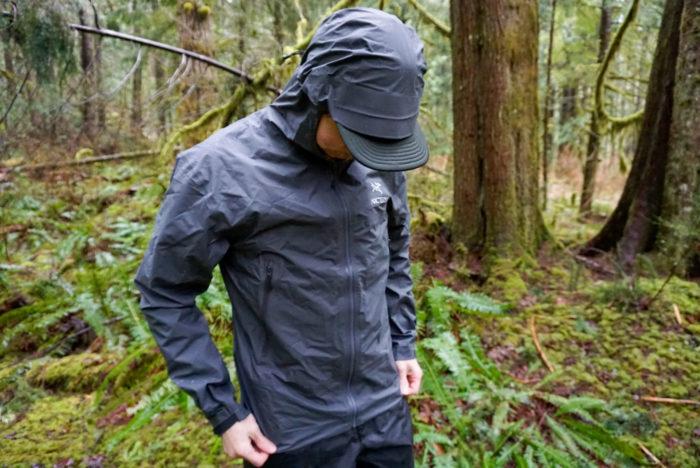
Fabric Layers
2-Layer
About as simple as simple gets, two-layer jackets utilize a waterproof membrane and outer face fabric to guard against scuffs and scrapes. These jackets often require hanging mesh linings to protect the waterproof membrane from abrasion, which ups the bulk and weight factor, but can also keep the cost down on entry-level pieces.
Without a full barrier protecting the interior of the jacket, the pores of the membrane can become clogged with time, and 2-layer jackets will need to be washed more often to keep them in fighting shape. The original formulation of GORE-TEX was a 2-layer layup, which boasted high breathability and waterproofing numbers but suffered in terms of durability as the membrane degraded with use. Today, all GORE membranes protect the interior of their membrane to prolong its life.
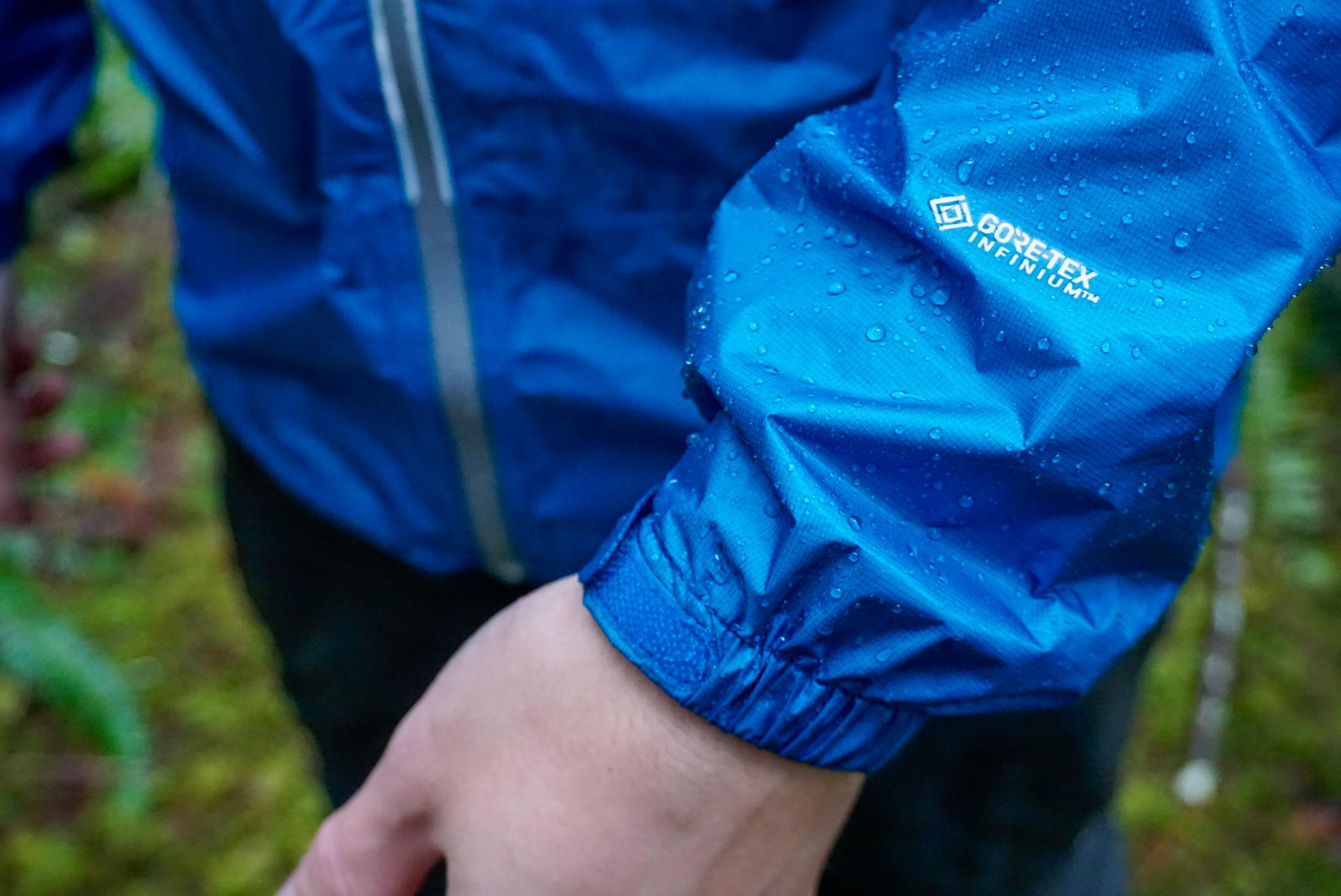
2.5-Layer
Jackets made with 2.5-layer fabrics incorporate a very thin protective lining to the inside of the waterproof membrane, which is typically laminated, screen printed, or sprayed on, and eliminates the need for a mesh lining and the bulk and weight that comes with it. These linings often increase the longevity and breathability of the jacket by decreasing the body oils and dirt that can clog the pores of the membrane.
One unfortunate drawback to these jackets is that they often feel clammy against the skin in continuous rain, and lack the moisture-wicking of three-layer jackets. Many may believe that their rain jacket has given up the ghost, when in fact it is the breathability that has been overwhelmed and caused a back-up of moisture coming from their own bodies.
3-Layer
By adding a third wicking textile to the interior of the membrane, three-layer jackets benefit from a significant bump in moisture management, but also typically in price. This is the realm of true all-day-deluge performance jackets, and most often use the big name-brand membranes that have come to dominate the industry, such as GORE-TEX or eVent.
This third layer also adds a good bit of durability to the jacket as it protects the waterproof membrane from abrasion, but will add some bulk over 2.5-layer jackets. Because they are more complex, 3-layer membranes often land in the performance category of rain jackets and carry higher prices to boot.
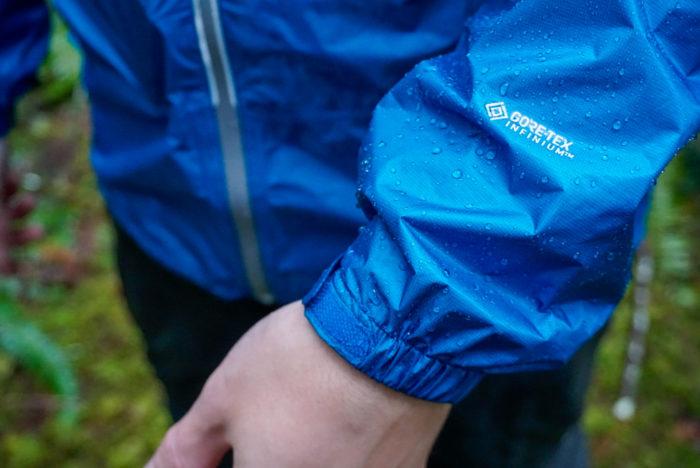
Waterproof Membranes
Waterproof membranes come in a number of flavors these days, but all operate on a similar principle: keep the rain out and keep perspiration from building up inside the shell. The construction of these membranes is often as mechanical as they are chemical, and the two big players today are ePTFE and polyurethane membranes, with air-permeable membranes on the rise.
Best thought of as a piece of plastic stretched very thin, ePTFE are specialty materials (polytetrafluoroethylene, to be specific) that are expanded, creating micropores that act as a filter to inhibit water penetration, but allow water vapor to be expelled. These ePTFE membranes have over 9 billion pores per square inch, each 20,000 times smaller than a water droplet, but 700 times larger than a water vapor molecule. This allows the membrane to resist water from the elements, but diffuse perspiration as it builds within the shell.
Most ePTFE waterproof membranes today also include a thin polyurethane coating or tricot backer on the inside to stop contaminants such as body oils from clogging these pores. The other majority share of waterproof membranes are made using a very thin sheet of polyurethane, which is naturally hydrophilic and maintains breathability through diffusion. These membranes have historically been monolithic, meaning that they lack any pore structure, but new technologies are producing air-permeable membranes that pass air freely.
Because they depend on diffusion to move perspiration from the inside, PU membranes require you to work up a bit of a sweat before they’ll really start to move moisture, which can lead to a slick interior if some mechanical ventilation isn’t employed.
New to the market in recent years and somewhat of a blend of both previous technologies, air-permeable membranes take the waterproof nature of polyurethane and create a matrix that allows for gaseous vapor transfer, as opposed to pure diffusion. Opening up the membranes in this way has led to great leaps in breathability, with membranes like The North Face’s FUTURELIGHT boasting a rating of 75,000 g/m².
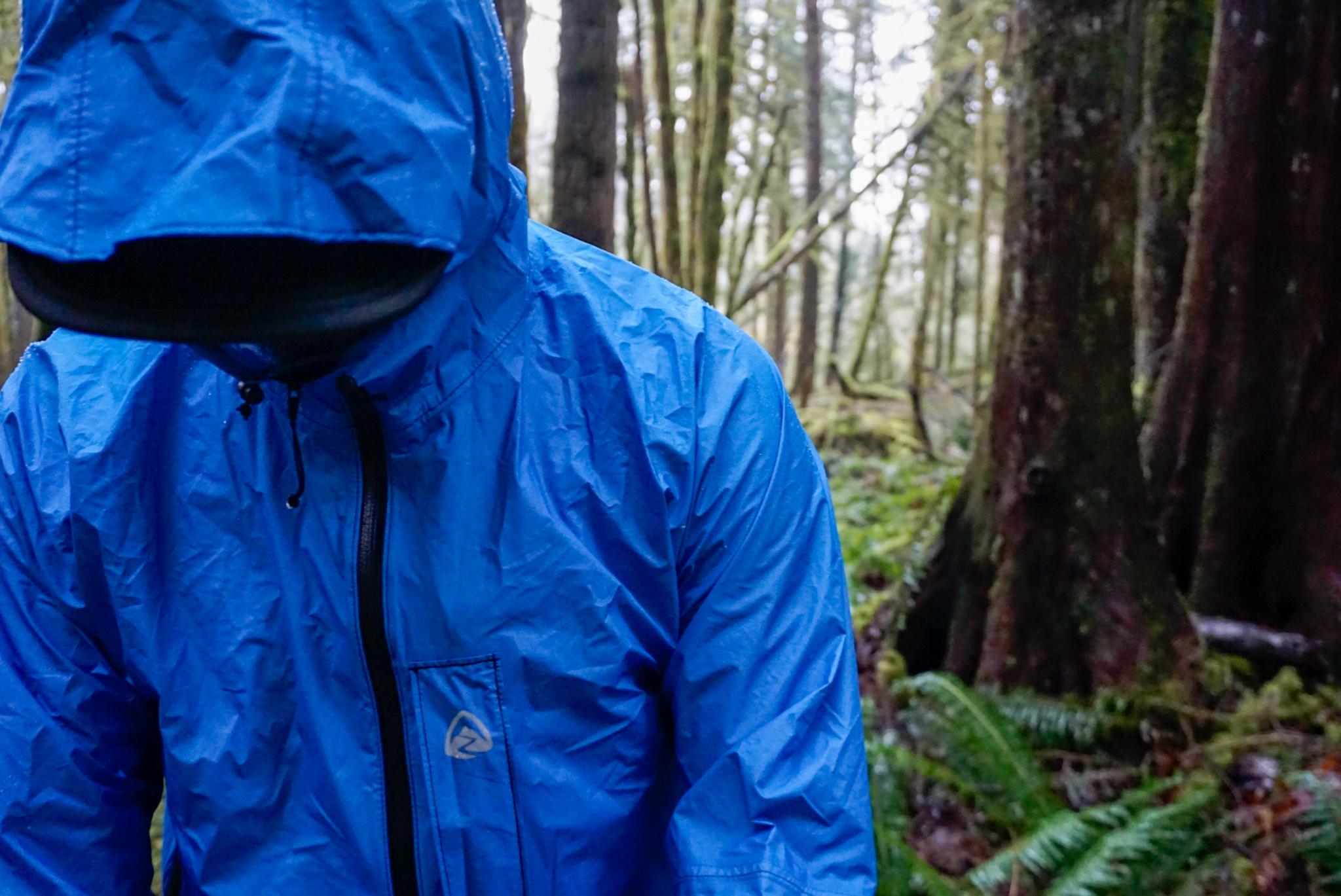
GORE-TEX PACLITE and PACLITE PLUS
PACLITE is widely used in hiking and backpacking rain jackets, as it offers a high waterproofing rating, but strips out the textile backer of 3-layer membranes and applies a layer of polyurethane and carbon on the interior. This makes a hanging mesh lining unnecessary, and creates rainwear that is impressively packable. This layer is less thin than the bonded interior materials of 3-layer membranes, and as such is known as a 2.5-layer technology.
When even more packability is needed such as during backpacking, Gore’s PACLITE PLUS is a membrane that cuts down on bulk even further by spraying a layer of polyurethane that is much thinner than regular PACLITE to increase durability. Because of this, we regard PACLITE PLUS as a 2-layer membrane, and at >28,000 mm/24 hours of water resistance, this technology is plenty waterproof — but its breathability suffers some at 15,000 g/m².
GORE-TEX ePE
Currently a fledgling on the market, the new ePE membrane from GORE-TEX is bound to spread into most garments that currently use the 3-layer version. Urged on by manufacturers who wanted a PFC-free version of the legacy membrane, GORE-TEX was able to strip out the fluoro from their ePTFE membranes by supplanting polyethylene in its place. The material is still expanded like the original recipe and nails the 28,000 mm water resistance rating that 3L GORE-TEX is known for.
The trade-off is in breathability, which is on the lower end of the spectrum at a RET rating of <13. This will mean that jackets made with ePE will need to lean more on mechanical ventilation to keep moisture moving throughout the jacket.

GORE-TEX Pro
Used in higher-end hardshell jackets where maximum protection from wild conditions is needed, Gore’s three-layer Pro membrane is made of several ePTFE membranes bonded together, and uses a Micro-Grid backer that cuts down on overall bulk. A >28,000mm water resistance and 24,000 g/m² breathability put GORE-TEX Pro jackets at the top of the heap. In recent years, multiple versions of GORE-TEX PRO have been produced, including Most Rugged, Most Breathable, and Stretch.
Because of the overall price associated with GORE-TEX Pro (hardshells begin at around $350, and rocket all the way to $900), it isn’t often that you see it utilized in rain jackets meant for everyday conditions.
GORE-TEX Active
The airiest of the GORE-TEX offerings, this variation of the GORE membrane boasts a higher breathability rating than other styles, making it ideal for high-exertion activities where moving water out is more important than keeping it out. Exterior face fabrics are between 13-30 denier, and the backer is a lightweight C-Knit material, which all aids in creating less of a barrier for moisture to move through during high-exertion activities. Few companies currently use the Active textile, with Norrøna and GORE WEAR currently creating trail running and cycling jackets utilizing it.

Pertex Shield+
Using a polyurethane film membrane, Pertex Shield+ is able to achieve a good balance of water resistance and breathability at 20,000 mm and 20,000 g/m², respectively. Produced as a 2.5-layer fabric, jackets made with these membranes can sometimes be overwhelmed by perspiration and feel slick to the touch.
Proprietary Membranes
These include numerous specialty textiles that are created directly for manufacturers to their specifications, which allows them to fine-tune their membranes as well as keep overhead costs down and produce more affordable rainwear. Examples include Outdoor Research’s AscentShell technology, Black Diamond’s BD.dry, and many more.
We’ve found that rain jackets made with proprietary membranes are often significantly less expensive than jackets using name-brand membranes.
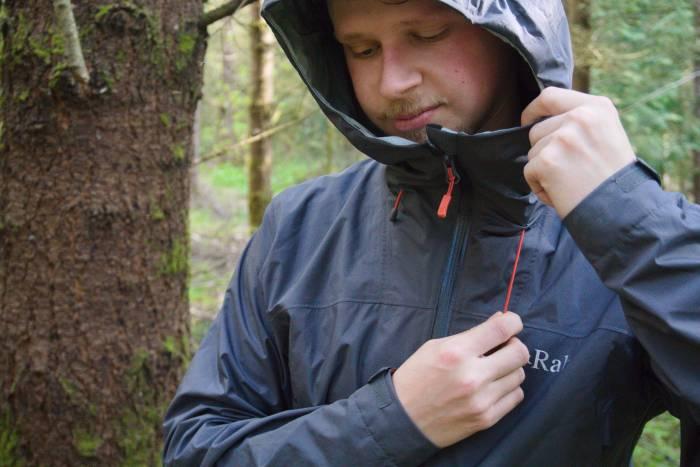
Durable Water-Repellent Finish (DWR)
The first line of defense for a rain jacket, a durable water-repellent finish (DWR) is a hydrophobic coating that gives it that ‘duck’s back’ look of rain beading away harmlessly. This keeps water from overwhelming the waterproof membrane and prolongs its ability to stay waterproof.
DWR coatings also affect the ability of the jacket to breathe, as a wetted-out face fabric will inhibit the jacket’s ability to expel moisture. Abrasion, oils, and trail funk can all degrade the coating, so keeping your rainwear clean and re-waterproofed is the best way to ensure that your jacket continues to function at peak performance, as we discuss below.
Historically made from environmentally harmful chemicals known as perfluorocarbons (PFCs), many companies are now working on using PFC-free DWR finishes in their rain jackets. Patagonia has pledged to use a PFC-free DWR in all of its outerwear by 2024, and REI recently announced that it would soon no longer carry products from brands that continue to use the chemicals. We are happy to see this trend spreading throughout the industry.
Comfort
It’s important that your rain jacket moves comfortably with you and does not overly restrict your movement. A comfortable rain jacket will keep you dry without feeling annoying or cumbersome.
A growing trend has been incorporating built-in stretch into rain jackets, which greatly increases their abilities where high mobility is needed. Jackets we reviewed like the Black Diamond StormLine Stretch andMountain Hardwear Stretch Ozonic Jacketincorporate stretch and will move with you outdoors.
Small features usually define the overall comfort of a rain jacket. For example, a hood that fully blocks peripheral vision will not be comfortable to use. Ideally, your rain jacket will minimally limit your range of motion, and the interior lining will feel good against your skin.

Weight & Packed Size
Most people agree weight is an important consideration for any piece of outdoor gear. If you’re going to be carrying your rain jacket in a pack when it isn’t in use, you want it to be as light and compact as possible — without sacrificing usability. Many lightweight rain jackets, like theMontbell Versalite or Patagonia Storm10, weigh less than a pound without sacrificing durability and functionality.
Many rain shells stuff easily into their own pockets and become barely larger than a baseball. Once packed down, it’s nice to have an external clip-in loop on the stuff sack — especially for multi-pitch rock climbing or backpacking. If your rain jacket packs down conveniently, you’re more likely to bring it along and have it when it’s needed most.
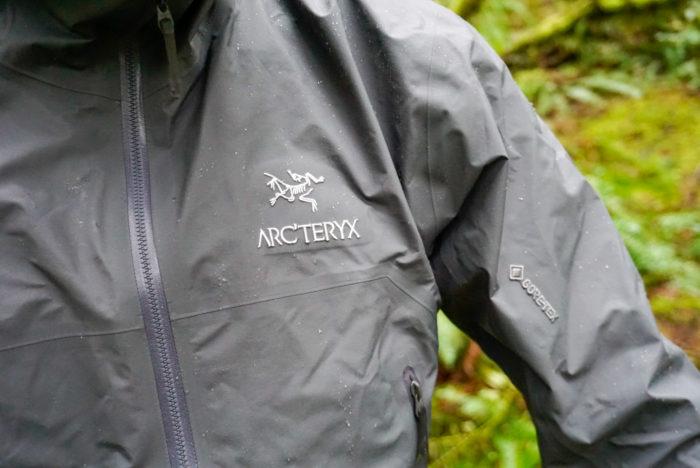
Zippers, Pockets, and Seams
It’s nice to have a well-placed pocket or two in your rain jacket. However, more pockets mean more material, and more material means increased weight and decreased packability.
Also, pockets create seams that may also decrease the waterproof capability of the jacket. Still, it’s nice to at least have two hand pockets to keep your hands warm and dry in a storm. Waterproof zippers on pockets and front zippers can add increased water resistance and protect your valuables inside. Also, rain jackets will often incorporate underarm zippers to increase ventilation.
Sewing together a rain jacket introduces hundreds of holes into the fabric, so most incorporate taped or bonded seams to ward off leaks. Seam tape can be added to all seams, or sometimes only essential seams, in order to save weight.
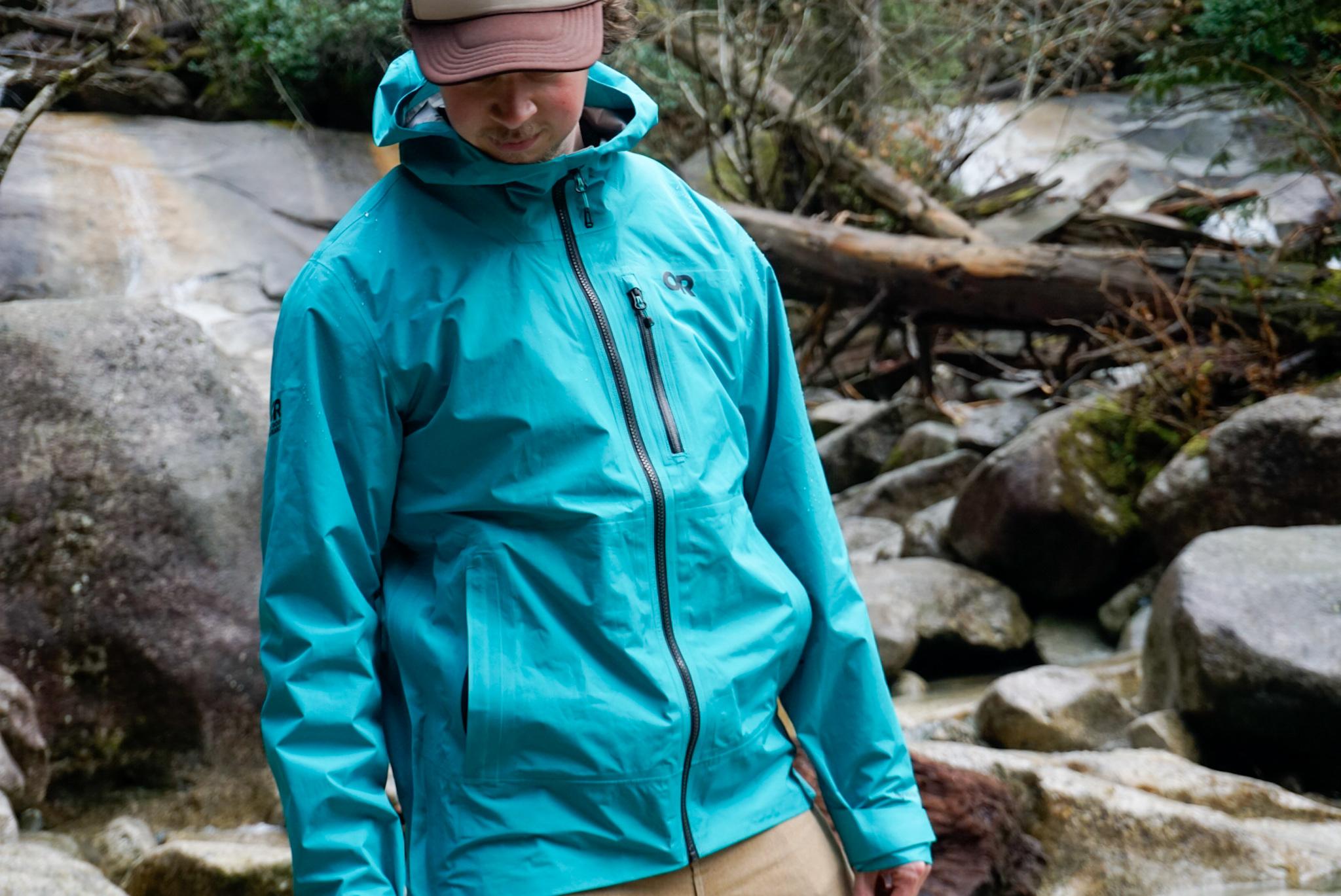
Hood
Some rain jackets have hoods that double as a convenient stuff sack. Generally, if it’s raining hard enough to warrant a rain jacket, you’ll probably also have the hood up.
A well-designed hood should be strategically designed to offer full protection without limiting peripheral vision. Adjustments can include a simple drawstring at the rear of the hood to pull the crown out of your eyes, as well as side profile adjustments for peripheral coverage, and wire-stiffened brims to keep rain from draining into the hood.
Finally, it’s also important to ensure that your hood will fit over any helmet you may be wearing. Typically seen in more sport-specific or hardshell jackets, helmet-compatible hoods provide a bit of extra space internally to accommodate your protective headwear.
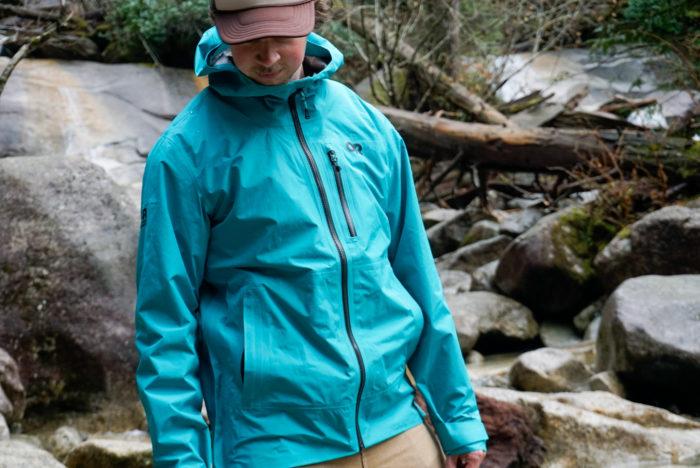
Extra Features
Ultimately, a rain jacket’s sole purpose is to keep moisture out. However, some jackets also include some extra features that add further value.
Some jackets come with features such as handwarmer pockets, large pit zips, and a roomy cut that allows space for warm layers underneath. These can be important to consider, as often rain jackets will be tailored to a certain range of uses.
For example, a rain jacket that is crafted for city use will likely forgo pit-zips and instead provide some roomy hand pockets — while a shell meant for all-day hiking should sport an accommodating profile and adjustable hood cinches.
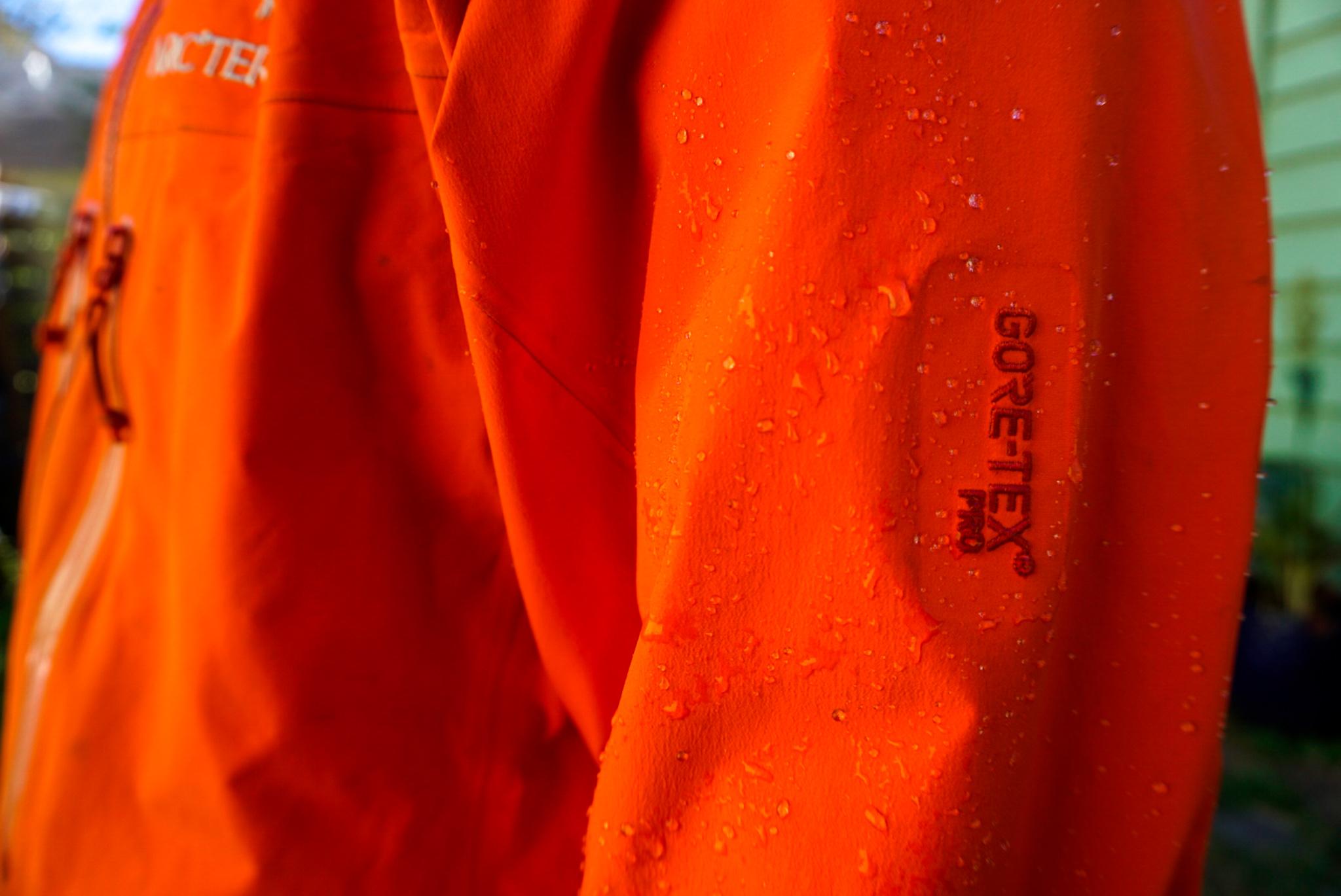
Sustainability
In striving to create the most waterproof membrane, the outdoor industry created a number of unsustainable practices which are slowly beginning to be rectified: using recycled materials, PFC-free DWR finishes, and ensuring sustainable practices are used during production.
Being Bluesign certified means that the fabric used in the jacket has passed an independent approval process to ensure that they are safe for the environment and consumers. A similar process is used in being Fair Trade Certified, where producers must ensure sustainable livelihoods for textile workers.
The most sustainable rain jacket in our review was the Patagonia Torrentshell 3L Jacket, which utilizes a 100% recycled face fabric, is Fair Trade Certified sewn, and is Bluesign approved.
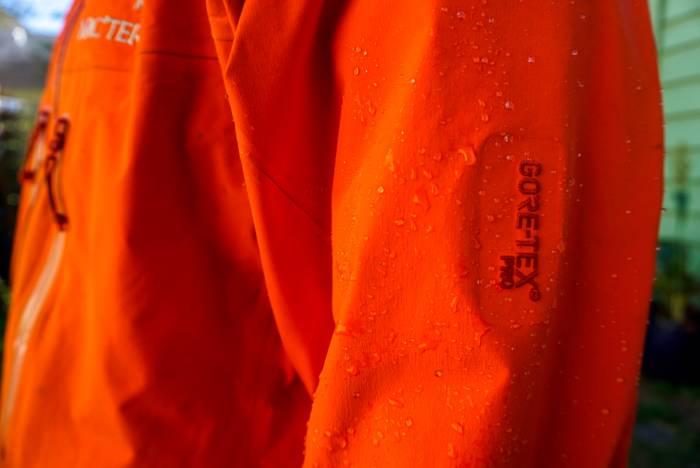
Durability and Caring for Your Rain Jacket
A rain jacket is designed to be exposed to the elements, and a good one will do its job without falling apart. As rain jackets become lighter, users should expect a dip in durability, too.
However, on this list, we’ve included rain jackets that are both lightweight and reliable. A jacket that is abrasion-resistant will have much greater overall longevity. Purchasing a shell that utilizes a higher denier face fabric, such as theArc’teryx Beta Jacket, will greatly increase its durability over time.
Often overlooked, regular upkeep of your rain jacket is essential to keeping the waterproof membrane happy and working as it was designed. When body oils and grime clog the interior pores, the breathability suffers, and a worn-away DWR finish does little to keep a jacket from wetting out. A quick and easy way to breathe some life into your DWR is a brief cycle in the dryer on medium heat.
When a more thorough cleaning is in order, begin by washing your rain jacket with a detergent that is made for waterproof fabrics, such as Nikwax Tech Wash. We’ve found that this will cleanse the waterproof membrane and allow it to function as designed.
You can go a step further by reapplying a fresh coat of DWR such as GEARAID Revivex Durable Water Repellent Spray, and then turning the jacket inside-out and drying it on high heat to set. This is a common fix and with frequent reapplication, it will keep water beading off your jacket when it counts.
